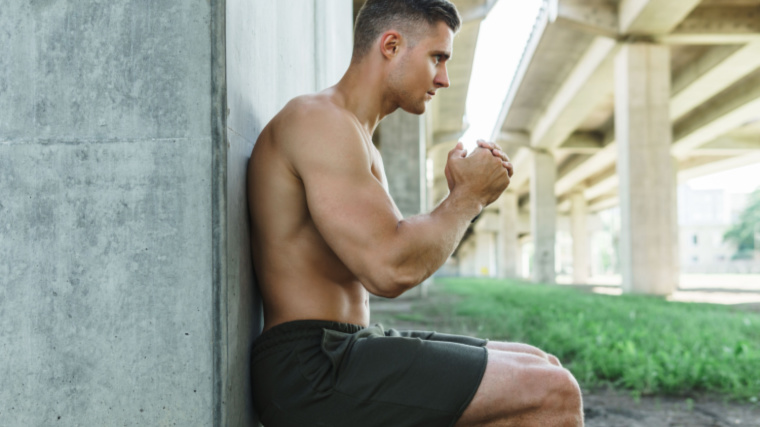Every core exercise has its place. Planks, for example, are a great introduction to ab workouts that you can do just about anywhere. You can then strengthen your abdominals quite a bit by performing moves like the hanging leg raise, cable crunch, or ab rollout.
But there’s something to be said for taking things back to basics once in a while. A good old-fashioned wall sit can be an invaluable tool whether you’re a rank beginner or an advanced trainee.

You can use the wall sit as a primer before more intense ab workouts, a teaching tool for practicing spinal alignment and proper breathing, and much more. Pull up a chair (not literally, though) — this is how to do a pristine wall sit.
- How to Do the Wall Sit
- Wall Sit Variations
- Wall Sit Alternatives
- Who Should Do the Wall Sit
- Wall Sit Sets and Reps
- Benefits of the Wall Sit
- Muscle Worked by the Wall Sit
- Common Wall Sit Mistakes
- Frequently Asked Questions
How To Do the Wall Sit
At a glance, the wall sit appears almost laughably simple: Find a wall, sit against it. While that is certainly a cursory overview of the movement, there are a lot of technical nuances that go into executing a wall sit that’s just right.
[Read More: 5 At-Home Workouts for Strength, Muscle Growth, Power, and More]
- Step 1 — Stand with your back to the wall, feet under your hips, with about two feet of space between your heels and the base of the wall.
- Step 2 — Reach behind you with your hands to brace yourself and lean backward until your spine connects with the wall from hip to neck.
- Step 3 — Slide down the wall by bending your knees until your legs form a 90-degree angle. Place your hands on your kneecaps, contract your core, and hold yourself in place.
Wall Sit Variations
As the wall sit is an isometric exercise (your body doesn’t move while you perform it), there are only so many tweaks you can make to it. But that doesn’t mean there are zero viable variations to play with. The weighted wall sit offers you an opportunity to incorporate progressive overload, and you can try the single-leg wall sit for an unparalleled unilateral challenge.
Weighted Wall Sit
[Read More: The 5 Best Quad Workouts for Forging Bigger and More Explosive Legs]
- Set up for a standard wall sit as you normally would.
- Once you’ve slid down into position, have a spotter place a small weight plate on top of your thighs.
- Hold the posture for time as usual. To increase the challenge over time, gradually add more weight each time you perform the weighted wall sit.
Single-Leg Wall Sit
[Read More: Nail the Front Squat for Leg Muscle and Power]
- Situate yourself into a standard wall sit with your legs bent at 90 degrees and your back flush against the wall.
- Inhale, brace your core hard, and shift your weight over to one leg.
- Then, slowly remove your other leg from the floor and extend that knee outward until your leg is mostly straight.
Wall Sit Alternatives
The wall sit is a stellar exercise for postural control and has an assortment of other benefits, but it’s hardly a must-do movement. If you want to reap the benefits of the wall sit but can’t stand doing them, try out one of these similar alternatives instead.
Dead Bug
[Read More: Master the Leg Curl for Stronger Hamstrings and Heavier Deadlifts]
- Lie flat on your back on the floor. Exhale to compress your lower back until it rests flush against the ground.
- Lift your arms up and point them at the ceiling.
- Lift your legs up, bend your knees at 90 degrees, and hold them steady.
Bear Plank
[Read More: The 17 Best Lower Body Exercises to Level-Up Your Leg Day]
- Get down onto your hands and knees on the floor.
- Flatten your spine such that it isn’t rounded over or visibly concave.
- From here, inhale and contract your abs hard.
- Then, lift your knees very slightly off the floor and hold that posture.
Who Should Do the Wall Sit
The wall sit isn’t just for those with a lot of time on their hands. You can use this exercise to strengthen your abs, or as a primer for more complicated movements afterward. Here are a few populations that could benefit from incorporating the wall sit:
Beginners
When you’re just starting out on your fitness journey, there’s no need to overcomplicate things. You don’t need to run through a host of awkward, cumbersome movements in order to strengthen your core.
In fact, for abdominal and postural training, less is often more. The wall sit can help you learn how to properly align your ribcage and pelvis, breathe while bracing your core, and more in a safe and accessible way.
Elderly Populations
Folks in their later years should absolutely perform certain weight-bearing exercises — almost always under the guidance of a qualified coach or personal trainer. Anyone who may not have the mobility or strength to do exercises like the hanging leg raise or bear plank should be able to do a wall sit.
You can also modify the wall sit easily to accommodate lower levels of strength. If you can’t hold your legs at 90 degrees, try suspending them at 45 degrees instead. It reduces the difficulty but still provides some core and leg-training benefits.
Strength Athletes
Isometric quad exercises like the wall sit can be useful for strength athletes as a prehab movement. Moreover, many barbell-based compound exercises, such as the squat, deadlift, or clean & jerk require tremendous amounts of isometric core strength.

[Read More: The 20 Best Ab Exercises for Strength and Definition]
The wall sit may not tax your abs to the same degree as a 1-rep-max deadlift, but strength athletes can certainly use it as part of their dynamic warm-up or as an accessory exercise.
Wall Sit Sets and Reps
Isometric exercises are generally performed for time, rather than a specific rep count, since reps are denoted by moving a joint from one position to another. However, you can still use the wall sit for different purposes depending on your goals:
- For Endurance: Perform a standard wall sit for 3 or 4 rounds of as long as possible.
- For Core Strength: Add a weight plate to your legs and hold the position for a few sets of 20 to 30 seconds. If it’s too easy, add more weight.
Benefits of the Wall Sit
A good core exercise should do more than just make your abs tired — and that’s exactly why the wall sit is so beneficial. Not only will the wall sit train your core directly, but it’ll also reinforce proper torso bracing and have your legs shaking by the end to boot.
Challenges Your Core
The wall sit is a core exercise first and foremost. Its main purpose is to force you to contract your rectus abdominis, obliques, and other small or deep abdominal muscles isometrically. This effect carries over to many other strength training movements, particularly ones where you need to hold your torso motionless while your arms work.
Teaches Proper Torso Alignment
Your abdominals primarily act to resist errant forces acting on your core, meaning they help keep your midline stable while you move or exercise. Part of this duty involves establishing and maintaining alignment between your ribcage and pelvis.

[Read More: The 7 Best Resistance Bands]
This is where the “wall” part of the wall sit becomes indispensable. When you set up for the wall sit, you press your lower back against the wall hard. This naturally “clamps” your ribcage down and prevents you from arching your back, which is the exact bracing posture you need to lift objects or heavy weights.
Works Your Legs
Make no mistake, the wall sit isn’t a leg exercise primarily. Most of the work comes from your hips and abs. That said, maintaining a bent knee for a specific amount of time will challenge the muscles around that joint as well, namely your quadriceps.
Muscles Worked by the Wall Sit
When you perform the wall sit, you engage a variety of different muscles in both your upper and lower body. Here are the major muscle groups involved in the wall sit:
Abdominals
The wall sit is, primarily, a core exercise. Your rectus abdominis, internal and external obliques, transverse abdominis, and even your lumbar spine to a degree all play a part in helping you maintain your posture.

[Read More: The 16 Best Pre-Workout Supplements]
That said, the wall sit is isometric in nature — your ab muscles don’t lengthen and contract against resistance. This means the wall sit is great for stability, but not so good for growing your abs.
Quadriceps
Your quadriceps are a large, strong muscle on the front of your thigh. Their primary function is to extend, or straighten, your knee — think squats, lunges, step-ups, and so on. As a result, your quadriceps have some part to play during the wall sit as well. They contract isometrically to keep your knee fixed in a bent position for the duration of the set.
Common Wall Sit Mistakes
The wall sit may be simple at a glance, but like any exercise you can still maximize its efficacy by doing it properly, and minimize its utility by making mistakes. Steer clear of these common errors and you’ll be golden:
Hands Pushing on Knees
You shouldn’t use your hands to support yourself during the wall sit. The purpose is to rely on both your core and your isometric leg strength to get the job done. You can gently rest your hands on your knees for balance, but avoid pressing against your legs to drive your back against the wall.
Arching Your Back
The wall sit is as much of a teaching tool as it is a core-builder. With your back flush against the wall, your ribcage and pelvis automatically come into alignment as you contract your abs. As such, you rob yourself of some of the utility of the exercise if your lower back can’t stay in contact with the wall.
Knees Too Straight
A good wall sit should have you suspended with your knees at, roughly, a 90-degree angle. The straighter your legs (and, thus, the higher you rest on the wall), the easier the movement will be. There’s certainly wiggle room to this
Take a Seat
Every core exercise has a purpose. Half the battle is about finding the right movement for your goals. You can put the wall sit to great use and develop unparalleled core stability along the way. Don’t overlook this move just because you aren’t using a bunch of weight — it just might surprise you.
FAQs
Still not sure if the wall sit is the right core move for you? Check out these common questions and answers.
Ideally, your legs should be bent at a 90-degree angle while maintaining your wall sit position. The straighter your legs are, the easier the move becomes.
No individual exercise burns belly fat. Fat loss is a result of increasing your physical activity while also eating fewer calories than you consume on a regular basis.
Featured Image: Bojan Milinkov / Shutterstock
The post How to Do the Wall Sit for Core Stability (+ Best Variations) appeared first on BarBend.
